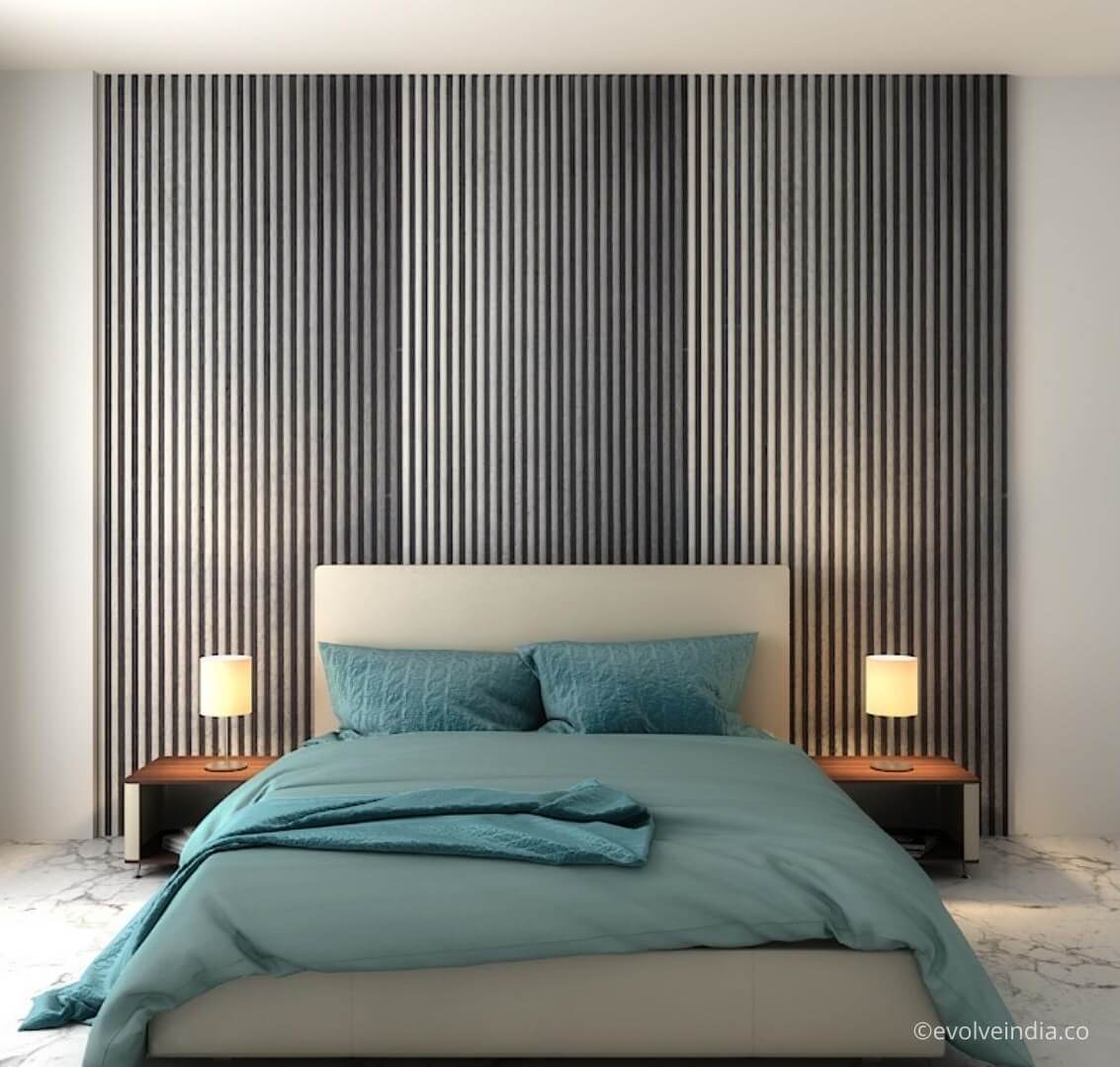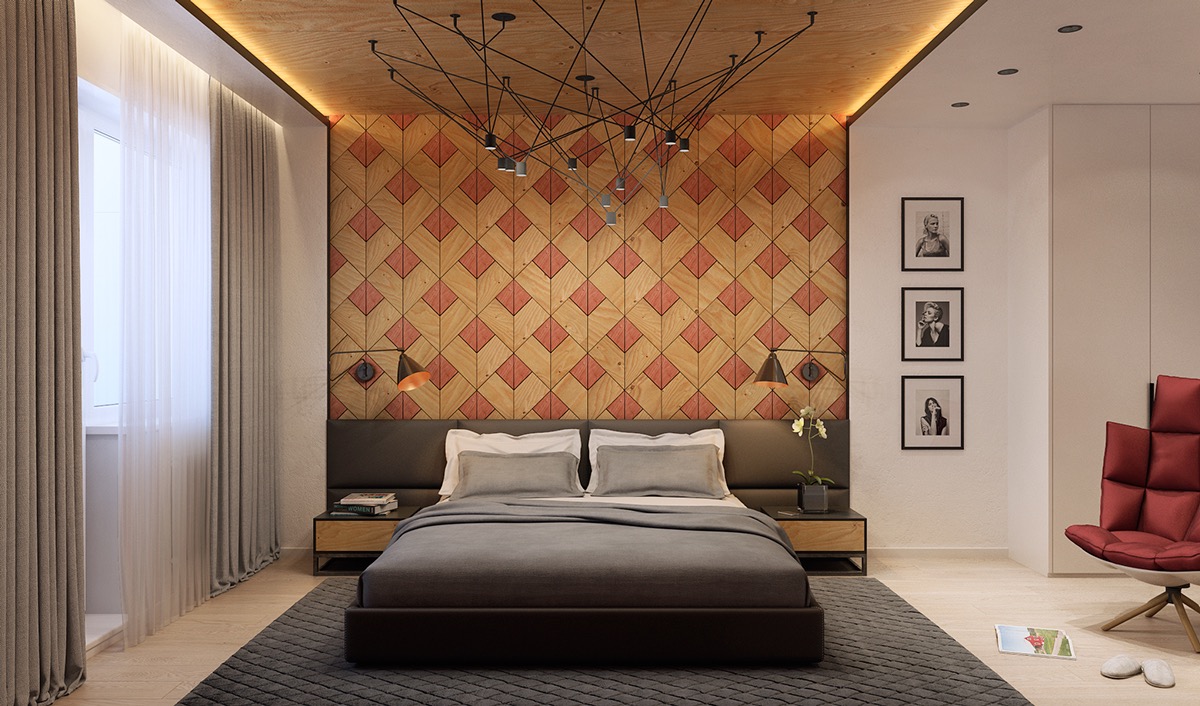Textured Accents and Focal Points: Simple Wall Texture Designs For Bedroom

Adding texture to your bedroom walls can create visual interest and depth, transforming a plain space into a more inviting and stylish one. By incorporating textured accents, you can highlight specific areas, draw the eye to focal points, and add a unique touch to your décor.
Using Textured Wall Panels or Wallpaper to Create a Focal Point
Textured wall panels or wallpaper can be used to create a dramatic focal point in a bedroom. These materials come in a wide variety of textures, patterns, and colors, allowing you to create a unique look that complements your personal style.
For example, you could use wood-paneled wallpaper to create a rustic and cozy feel, or embossed wallpaper with a geometric pattern to add a modern touch. A textured wall panel behind the bed can serve as a stunning headboard, adding visual interest and a sense of sophistication.
Incorporating Textured Accents to Highlight Specific Areas
Textured accents can be used to highlight specific areas in a bedroom, such as a headboard or a reading nook. For instance, you could use a textured wallpaper with a subtle pattern to create a soft, inviting atmosphere around a reading nook. This creates a visual separation within the room, making the space feel more defined and inviting.
Using textured accents to highlight specific areas in a bedroom can create a more balanced and visually appealing space.
Designing a Bedroom Wall Texture with a Textured Accent Wall
To design a bedroom wall texture with a textured accent wall behind the bed, you can start by choosing a base color for the majority of the walls. This color should be neutral and complement the overall design of the room. Then, select a contrasting color for the accent wall behind the bed. The contrasting color should be bolder and more visually striking, creating a focal point and adding depth to the room.
For example, if the base color is a light gray, you could choose a dark teal for the accent wall behind the bed. You can then incorporate a textured wallpaper or wall panel in a complementary pattern or texture to add visual interest to the accent wall. For example, you could use a wallpaper with a subtle geometric pattern or a textured wall panel with a wood-like finish.
Creative and Unique Techniques

Beyond basic paint techniques, there are many creative and unique ways to add texture to your bedroom walls. These methods often involve readily available materials and can be customized to suit your personal style and preferences.
Using Fabric for Texture
Fabric can be used to create interesting and unique wall textures. The process involves adhering fabric to the wall using a strong adhesive, such as wallpaper paste or fabric glue.
Here are some fabric options:
- Burlap: Burlap is a coarse, natural fabric that creates a rustic and organic look. It is often used to create a farmhouse-style aesthetic.
- Linen: Linen is a lightweight, natural fabric that creates a soft and elegant texture. It is often used in bedrooms with a minimalist or Scandinavian design.
- Velvet: Velvet is a luxurious fabric that adds a touch of opulence to a bedroom. It is often used in bedrooms with a glamorous or modern design.
Advantages: Fabric can add a unique visual appeal and texture to your walls. It is a relatively inexpensive and easy-to-apply material.
Disadvantages: Fabric can be prone to dust and dirt accumulation. It is also not as durable as other wall textures, such as paint or wallpaper.
Creating Textured Effects with Paint
Paint can be used to create a variety of textured effects on your bedroom walls. Here are some techniques that use readily available materials and tools:
- Sponge Painting: This technique involves using a sponge to apply paint to the wall, creating a stippled effect. The sponge can be dipped in different colors to create a multi-dimensional look.
- Rag Rolling: This technique involves using a crumpled rag or piece of cloth to apply paint to the wall, creating a textured and distressed look. The rag can be dipped in different colors to create a layered effect.
- Spatter Painting: This technique involves using a brush or a toothbrush to splatter paint onto the wall, creating a random and organic texture. The splatter can be controlled by the amount of paint used and the distance from the wall.
Advantages: Paint is a versatile material that can be used to create a variety of textured effects. It is also relatively inexpensive and easy to apply.
Disadvantages: Paint can be messy and may require multiple coats to achieve the desired texture.
Step-by-Step Guide to Sponge Painting, Simple wall texture designs for bedroom
This guide provides a step-by-step approach to creating a simple textured paint finish using a sponge.
Materials:
- Paint (choose a color that complements your bedroom decor)
- Paint tray
- Roller
- Paintbrush
- Sponge (natural sea sponge or a kitchen sponge)
- Drop cloth
- Masking tape (optional)
Steps:
- Prepare the Wall: Clean the wall with a damp cloth and allow it to dry completely. If necessary, use sandpaper to smooth out any rough spots.
- Apply Base Coat: Apply a base coat of paint to the wall using a roller. Allow the base coat to dry completely before proceeding.
- Prepare the Sponge: Dip the sponge into the paint, removing excess paint by pressing it against the side of the paint tray.
- Apply the Texture: Dab the sponge onto the wall, using a light touch. Avoid pressing too hard, as this can create uneven texture.
- Overlap the Strokes: Overlap the sponge strokes to create a continuous texture. Work in small sections, moving from top to bottom.
- Allow to Dry: Allow the textured paint to dry completely before applying a second coat if necessary.
Simple wall texture designs for bedroom can add a touch of visual interest without overwhelming the space. A subtle textured paint or wallpaper can create a calming ambiance, and when combined with a floating wall shelf bedroom design, can create a sense of both visual interest and functionality.
Adding a floating shelf or two allows you to display books, plants, or other decorative items, adding a personal touch to your bedroom’s design.
Simple wall texture designs for bedrooms can add a touch of visual interest without overwhelming the space. A subtle textured finish can create a calming atmosphere, particularly when paired with a soothing color like lavender. This color choice can enhance the feeling of serenity, making it an ideal backdrop for simple textures like a smooth plaster finish or a lightly stippled effect.